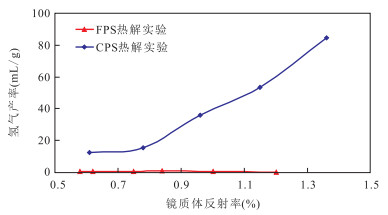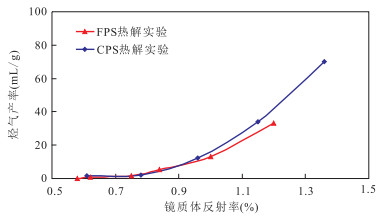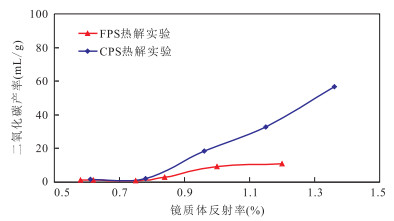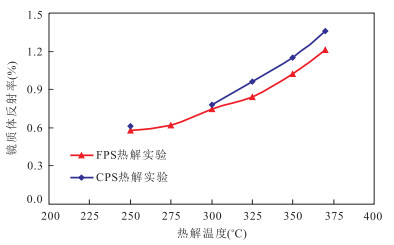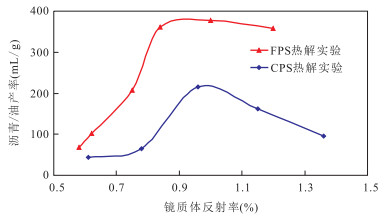Key Geological Conditions Affecting Pyrolysis Experiments of Marine Source Rocks for Hydrocarbon Generation
-
摘要: 热解生烃实验是研究油气生成机理与定量评价烃源岩生烃潜力的重要方法.烃源岩热解生烃模拟结果不仅与温度、压力和时间等因素有关,而且与地层孔隙水及压实成岩作用等地质因素密切相关.采用高压流体和高压釜(低压水蒸气)两种生烃热模拟方法对低成熟海相二叠统大隆组(P2d)黑色泥岩进行了热解生烃实验模拟.对比分析两组实验结果表明地层孔隙热解实验有利于液态油的生成,不利于液态油向气态烃的转化,并极大地提高了干酪根的生油气潜力,显示了高压液态水、流体压力和孔隙空间等地质因素对烃源岩中有机质热成熟生烃反应的重要影响.这种影响可能与高压液态水的近临界特性有关,近临界特性地层水的参与改变了干酪根热力生烃反应的物理化学行为.推断在实际地质温压(100~200 ℃,30~120 MPa)条件下,烃源岩孔隙中的地层水是一种相对低温高压液态水,具有水的近临界物理化学特性,因此高压流体生烃热模拟实验与实际地层情况更为接近,能更有效地评价烃源岩生烃潜力.Abstract: Hydrocarbon generation simulation experiment (pyrolysis) is important for studying petroleum generation mechanisms and quantitatively estimating hydrocarbon generation potential of source rocks. The simulation experiment results not only depend on the temperature, pressure and duration, but also on the pore fluid, source rock compaction. In this paper, marine black mudstone with low maturity from the Permian Dalong Formation (P2d) is used for hydrocarbon generation simulations with two types of high-pressure liquid water and low-pressure water steam. The results show that the high-pressure liquid water can increase the organic matter petroleum generation potential greatly, enhancing oil generation and retarding the transformation from oil to gas, suggesting important influence of geological factors such as high-pressure liquid water, fluid pressure and pore space on the hydrocarbon generation of the source rocks. The increase of the petroleum generation potential is due to the fact that the physicochemistry reaction of the kerogen is greatly enhanced at the presence of the near-critical properties water. It is concluded that the water in the pore space of the source rocks is of the high-pressure and low-temperature liquid water in the subsurface temperature (100-200 ℃) and pressure (30-120 MPa) conditions, which has the properties of near-critical water. Therefore, the hydrocarbon generation simulation experiment (pyrolysis) with high-pressure liquid water is more close to the actual geological conditions than that of the low pressure water steam and could be used to estimate hydrocarbon generation potential of source rock more effectively.
-
图 1 两种热解生烃模拟实验仪的原理结构示意
图 1a:FPS热解生烃模拟实验仪;1.液压控制系统;2.温度传感器;3.高压反应釜;4.油缸A;5.油缸B;6.箱式电热炉;7.四通阀;8.压力传感器;9.高压气动阀;10.二位三通电磁阀;11.减压阀;12.气瓶;13.气液分离器;14.冷阱;15.真空表;16.电动阀;17.储气室;18.活塞容器;19.截止阀;20.高压器;21.真空泵;22.压力表;23.三通阀.图 1b:CPS热解生烃模拟实验仪;1.箱式电热炉;2.样品;3.传感器探头;4.高压反应釜;5.温度传感器;6.压力传感器;7.四通阀;8.截止阀;9.真空泵;10.气液搜集器;11.杜瓦瓶冷阱;12.气体定量瓶;13.高低瓶;14.排水集气瓶;15.控制器
Fig. 1. The principle sketch of the two physical simulation apparatus for the hydrocarbon generation
表 1 两种不同模拟方式的实验边界条件
Table 1. Experiments boundary conditions for the two types of pyrolysis simulation experiments
模拟方式 模拟温度(℃) 恒温时间(h) 静岩压力(MPa) 流体压力(MPa) 加水量(mL) 生烃空间(mL) 序号 FPS CPS FPS CPS FPS CPS FPS CPS 1 250 48 43 0 19.8 5.9 21 10 21 450 2 275 48 47 0 22.7 - 21 - 21 - 3 300 48 58 0 27.4 8.6 21 10 21 450 4 325 48 66 0 30.6 11.8 20 10 21 450 5 350 48 71 0 34.5 13.4 19 10 21 450 6 370 48 75 0 37.9 17.1 17 10 21 450 表 2 两种热解实验条件下气体组分数据
Table 2. Gas components for the two types of pyrolysis simulation experiments
热解方式 热解温度(℃) 250 275 300 325 350 370 FPS CPS FPS FPS CPS FPS CPS FPS CPS FPS CPS H2 0.49 73.94 11.67 14.46 76.76 9.83 53.56 0.78 43.95 0.42 39.81 CO2 3.89 14.79 32.47 30.65 11.22 34.34 27.33 23.05 26.99 22.65 26.55 CH4 0.31 5.62 15.33 30.56 8.95 30.13 10.42 42.55 13.77 43.19 16.74 C2H6 0.03 0.50 2.10 14.21 0.62 14.33 4.46 21.33 7.13 20.16 7.65 C2H4 0.00 0.16 0.03 0.01 0.22 0.01 0.13 0.01 0.10 0.00 0.05 C3H8 0.01 0.14 0.98 4.14 0.18 4.85 1.68 7.83 3.42 8.45 4.34 C3H6 0.01 0.09 0.05 0.02 0.11 0.03 0.29 0.02 0.39 0.02 0.22 iC4H10 0.00 0.01 0.13 0.36 0.01 0.57 0.19 0.91 0.49 1.08 0.69 nC4H10 0.00 0.03 0.27 0.68 0.03 1.50 0.51 1.86 1.14 2.19 1.67 C4H8 0.00 0.01 0.02 0.00 0.01 0.01 0.07 0.01 0.13 0.01 0.11 iC5H12 0.00 0.00 0.06 0.08 0.01 0.34 0.11 0.30 0.24 0.37 0.42 nC5H12 0.00 0.01 0.05 0.04 0.01 0.36 0.14 0.23 0.32 0.27 0.51 C6+ 0.00 0.03 0.06 0.01 0.04 0.30 0.25 0.05 0.65 0.06 0.55 C1/(C1-C4) 0.85 0.85 0.80 0.61 0.88 0.57 0.57 0.57 0.50 0.57 0.51 表 3 两种热解实验气体与沥青产率值
Table 3. Gas and bitumen generation rates in the two types of pyrolysis simulation experiments
热解温度(℃) Ro(%) CO2产率
(mL/g)H2产率
(mL/g)烃气产率
(mg/g)沥青/油产率
(mg/g)FPS CPS FPS CPS FPS CPS FPS CPS FPS CPS 250 0.58 0.61 1.25 1.89 0.28 12.38 0.18 1.15 68.06 13.53 275 0.62 - 1.16 - 0.42 - 0.63 - 102.79 - 300 0.75 0.78 0.90 2.26 0.42 15.44 1.53 1.69 207.06 65.18 325 0.84 0.96 3.04 18.36 0.87 35.98 5.24 14.24 361.39 215.65 350 1.02 1.15 9.14 32.89 0.31 53.57 33.19 43.72 376.56 161.37 370 1.21 1.36 10.92 56.54 0.20 84.79 41.21 91.13 358.44 95.36 表 4 两种热解实验固体残样岩石热解参数
Table 4. Rock pyrolysis data for the residues in the two types of pyrolysis simulation experiments
温度(℃) Ro(%) S1(mg/g) S2(mg/g) Tmax(℃) PC(%) TOC(%) HI(mg/g) FPS CPS FPS CPS FPS CPS FPS CPS FPS CPS FPS CPS FPS CPS 250 0.58 0.61 1.79 1.35 39.78 40.25 437 435 3.47 3.42 12.32 12.04 323 334 275 0.62 1.20 - 40.94 - 435 - 3.52 - 11.98 - 342 - - 300 0.75 0.78 2.42 0.40 32.65 37.96 439 437 2.93 3.24 10.31 11.85 317 320 325 0.84 0.96 3.08 4.51 29.58 30.13 439 440 2.74 2.91 9.39 11.7 315 258 350 1.02 1.15 6.64 3.19 18.08 14.19 441 451 1.67 1.46 11.59 10.95 156 130 370 1.21 1.36 5.77 1.97 10.23 5.90 441 458 1.34 0.67 10.57 10.54 97 56 -
Carr, A.D., Snape, C.E., Meredith, W., et al., 2009. The Effect of Water Pressure on Hydrocarbon Generation Reactions: Some Inferences from Laboratory Experiments. Petroleum Geoscience, 15(1): 17-26. doi: 10.1144/1354-079309-797 Chen, J.Y., Liu, G.Y., Jin, L.J., 2009. Water in the Earth's Interior and Abiotic Formation of Hydrocarbon. Earth Science Frontiers, 16(1): 33-40 (in Chinese with English abstract). Chen, J.Y., Zhang, H., Zheng, H.F., et al., 2006. In Situ Visualization of Pyrolysis of Organic Matter in High-Temperature and High-Pressure Water—Taking Kerogen and Asphalt as an Example. Petroleum Geology & Experiment, 28(1): 73-77 (in Chinese with English abstract). Gao, G., 2000. Method of Petroleum-Generating Simulation and Its Petroleum Geological Significance. Natural Gas Geoscience, 11(2): 25-29 (in Chinese with English abstract). Gao, G., Gang, W.Z., Hao, S.S., 1995. An Approach to the Genesis of Carbon Dioxide from the Thermal Hydrolysis Modelling Experiment of Carbonate Source Rocks. Experimental Petroleum Geology, 17(3): 210-213 (in Chinese with English abstract). http://en.cnki.com.cn/Article_en/CJFDTOTAL-SYSD502.013.htm Helgeson, H.C., Knox, A.M., Owens, C.E., et al., 1993. Petroleum, Oil Field Waters, and Authigenic Mineral Assemblages are They in Metastable Equilibrium in Hydrocarbon Reservoirs. Geochimica et Cosmochimica Acta, 57(14): 3295-3339. doi: 10.1016/0016-7037(93)90541-4 Jiang, F., Zhang, Y.L., Du, J.G., 1996. Advance of Pyrolysis Experimentation on Hydrocarbon Genesis. Advance in Earth Sciences, 11(5): 453-459 (in Chinese with English abstract). http://en.cnki.com.cn/Article_en/CJFDTOTAL-DXJZ605.004.htm Lewan, M.D., Winters, J.C., McDonald, J.H., 1979. Generation of Oil-Like Pyrolyzates from Organic-Rich Shales. Science, 203(4383): 897-899. doi: 10.1126/science.203.4383.897 Lewan, M.D., 1997. Experiments on the Role of Water in Petroleum Formation. Geochimica et Cosmochimica Acta, 61(17): 3691-3723. doi: 10.1016/S0016-7037(97)00176-2 Lewan, M.D., 1998. Sulphur-Radical Control on Petroleum Formation Rates. Nature, 391(6663): 164-166. doi: 10.1038/34391 Liu, W.H., Wang, W.C., 2000. The Organic (Biogenic) and Inorganic (Non-Biogenic) Sources of Hydrocarbons—Thought on Theory of Oil and Gas Formation. Bulletin of Mineralogy, Petrology and Geochemistry, 19(3): 179-186 (in Chinese with English abstract). http://en.cnki.com.cn/Article_en/CJFDTOTAL-KYDH200003008.htm Qin, J.Z., Liu, J.W., Liu, B.Q., et al., 2002. Hydrocarbon Yield and Geochemical Parameters Affected by Heating Time and Added Water Amount in the Simulation Test. Petroleum Geology & Experiment, 24(2): 152-157 (in Chinese with English abstract). Seewald, J.S., 2003. Organic-Inorganic Interactions in Petroleum-Producing Sedimentary Basins. Nature, 426(6964): 327-333. doi: 10.1038/nature02132 Tissot, B.P., Welte, D.H., 1978. Petroleum Formation and Occurrence: A New Approach to Oil and Gas Exploration. Springer-Verlag, New York. Wang, X.F., Liu, W.H., Xu, Y.C., et al., 2006. The Thermal Simulation Experiment of Water in the Organic Matter in the Formation of Gaseous Hydrocarbon Evolution. Progress in Natural Science, 16(10): 1275-1281 (in Chinese). Wang, X.X., Wang, G.L., Cai, J.G., et al., 2006. Organic-Clay Complex and Hydrocarbon Generation. Petroleum Industry Press, Beijing, 126-134 (in Chinese). Zheng, L.J., Qin, J.Z., He, S., et al., 2009. Preliminary Study of Formation Porosity Thermocompression Simulation Experiment of Hydrocarbon Generation and Expulsion. Petroleum Geology & Experiment, 31(3): 296-302, 306 (in Chinese with English abstract). http://en.cnki.com.cn/Article_en/CJFDTOTAL-SYSD200903019.htm Zhou, S.X., Zou, H.L., Xie, Q.L., et al., 2006. Organic-Inorganic Interactions during the Formation of Oils in Sedimentary Basin. Natural Gas Geoscience, 17(1): 42-47 (in Chinese with English abstract). 陈晋阳, 刘桂洋, 金鹿江, 2009. 地球内部水与无机成烃. 地学前缘, 16(1): 33-40. https://www.cnki.com.cn/Article/CJFDTOTAL-DXQY200901011.htm 陈晋阳, 张红, 郑海飞, 等, 2006. 高温高压下水中有机质降解过程的原位观测——以干酪根和沥青质为例. 石油实验地质, 28(1): 73-77. https://www.cnki.com.cn/Article/CJFDTOTAL-SYSD200601013.htm 高岗, 2000. 油气生成模拟方法及其石油地质意义. 天然气地球科学, 11(2): 25-29. https://www.cnki.com.cn/Article/CJFDTOTAL-TDKX200002004.htm 高岗, 刚文哲, 郝石生, 1995. 碳酸盐烃源岩加水热模拟实验中二氧化碳成因探讨. 石油地质实验, 17(3): 210-213. https://www.cnki.com.cn/Article/CJFDTOTAL-SYSD502.013.htm 姜峰, 张友联, 杜建国, 1996. 油气生产热模拟实验研究进展. 地球科学进展, 11(5): 453-459. doi: 10.3321/j.issn:1001-8166.1996.05.005 刘文汇, 王万春, 2000. 烃类的有机(生物)与无机(非生物)来源——油气成因理论思考之二. 矿物岩石地球化学通报, 19(3): 179-186. doi: 10.3969/j.issn.1007-2802.2000.03.007 秦建中, 刘井旺, 刘宝泉, 等, 2002. 加温时间、加水量对模拟实验油气产率及地化参数的影响. 石油实验地质, 24(2): 152-157. https://www.cnki.com.cn/Article/CJFDTOTAL-SYSD200202011.htm 王晓峰, 刘文汇, 徐永昌, 等, 2006. 水在有机质形成气态烃演化中作用的热模拟实验研究. 自然科学进展, 16(10): 1275-1281. https://www.cnki.com.cn/Article/CJFDTOTAL-ZKJZ200610011.htm 王行信, 王国力, 蔡进攻, 等, 2006. 有机粘土复合体与油气生成. 北京: 石油工业出版社, 126-134. 郑伦举, 秦建中, 何生, 等, 2009. 地层孔隙热压生排烃模拟实验初步研究. 石油实验地质, 31(3): 296-302, 306. https://www.cnki.com.cn/Article/CJFDTOTAL-SYSD200903019.htm 周世新, 邹红亮, 解启来, 等, 2006. 沉积盆地油气形成过程中有机-无机相互作用. 天然气地球科学, 17(1): 42-47. https://www.cnki.com.cn/Article/CJFDTOTAL-TDKX200601009.htm -










 下载:
下载:
